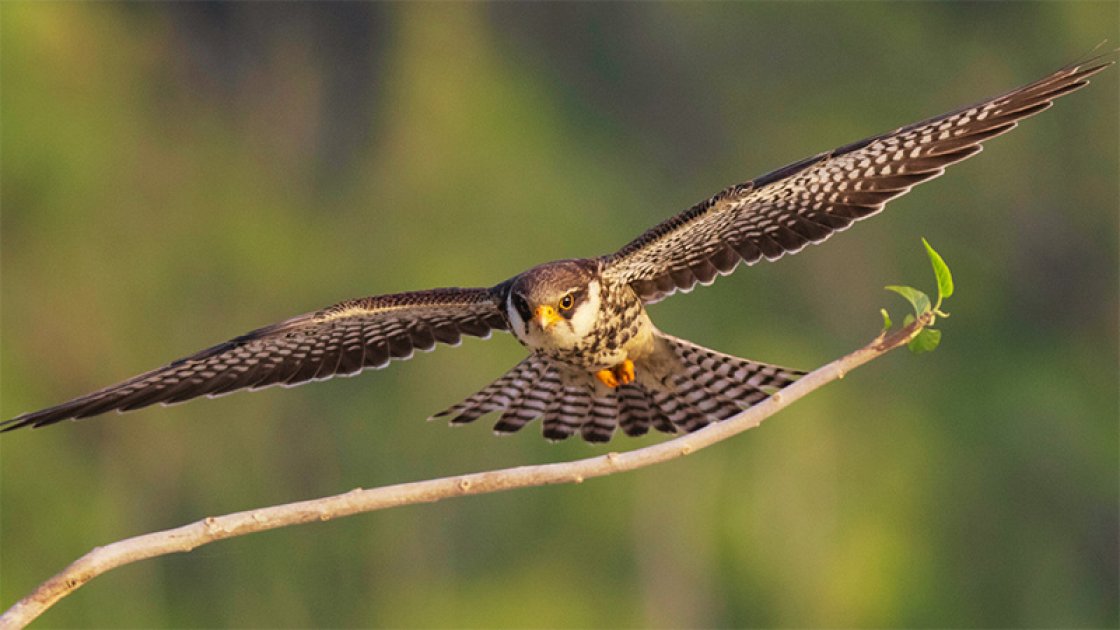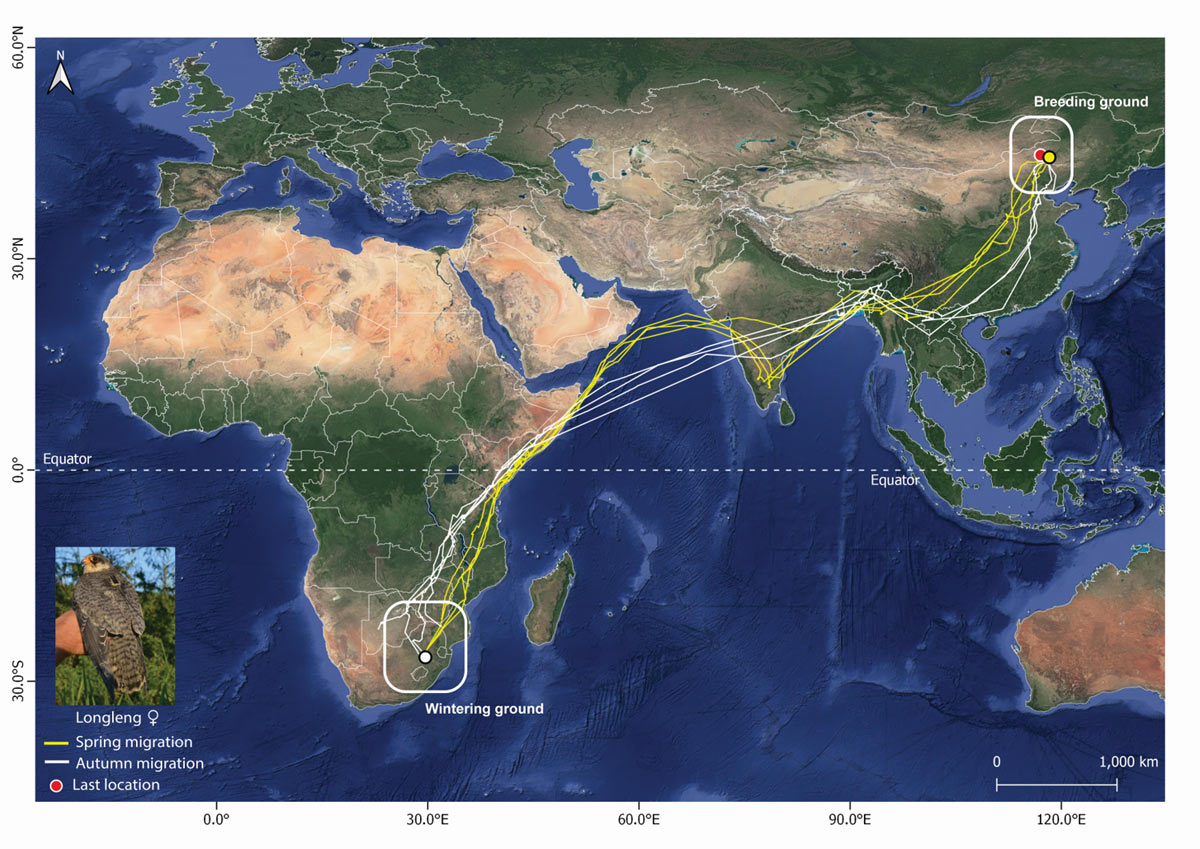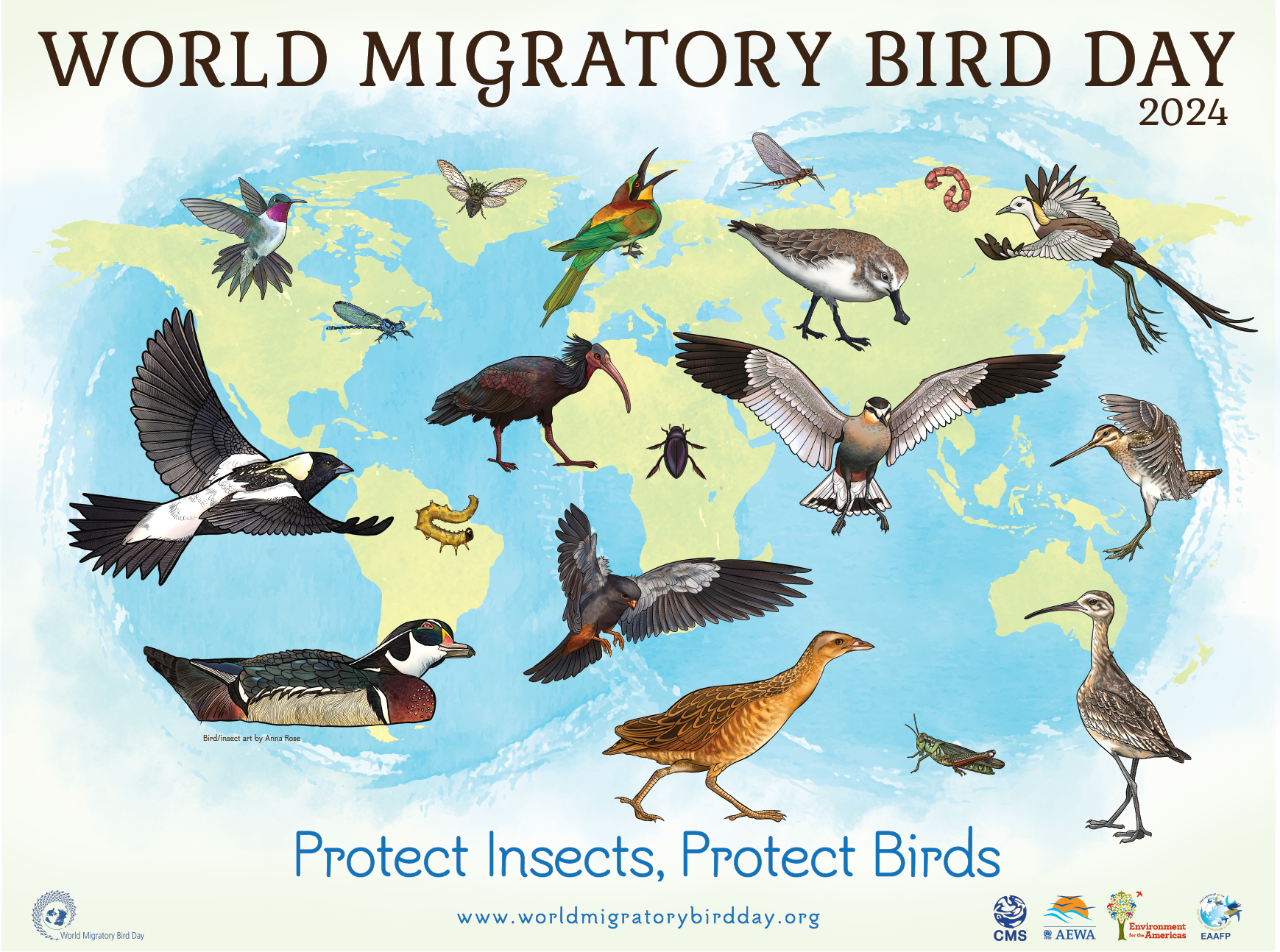You are here
The Interconnected Journey: Birds, Insects, and the Battle for Biodiversity

The Amur Falcon’s Remarkable Migration and the Importance of Insects for Its Survival
The Amur Falcon (Falco amurensis), a small but extraordinary bird of the raptor family, proves its resilience each year by migrating more than 30 000 kilometres. It undertakes the longest known transoceanic migration of any raptor species, with a non-stop flight over open water for several days.
From May to June each year, hundreds of thousands of Amur Falcons arrive in Eastern and Central Asia to raise their young near the Amur River, to which they owe their name. In late October and early November, they embark on an arduous flight over the Arabian Sea and Indian Ocean to migrate to their non-breeding areas in Southern Africa. To mark the cyclical migration of birds such as the Amur Falcon, World Migratory Bird Day is celebrated twice every year – in May and in October.
On its way to Africa, the small raptor chooses to spend a few weeks in Nagaland, a region located in Northeastern India, to gain strength and energy for the subsequent journey to Africa. This preference can be explained by the mass emergence of termites in this region, which favor the warm weather and moist soil after the rainy season.
The importance of insects, particularly termites, for the Amur Falcons’ survival is highlighted by the fact that their return migration to nesting grounds is much faster than their migration to non-breeding areas in Africa. While a quicker migration back to nesting grounds generally helps the first birds secure better breeding sites, the shorter migration could also be because they do not stopover in Nagaland on their return journey to Asia, as termites are less abundant there at that time of the year.
The Crucial Role of Insects in Bird Migration and Ecosystem Health
A large number of birds rely on insects to feed their offspring and gain strength during periods of migration. However, the very phenomenon of bird migration is under threat because of dramatic declines in insect populations in many parts of the world. According to estimates in research published by Biological Conservation in 2019, 40% of the insect species’ populations in Europe and North America are decreasing dramatically, with bees, ants, and beetles disappearing at a much faster rate because of intensive agriculture (especially due to the use of insecticides and herbicides), deforestation, urban development, climate change and light pollution. Many of our planet’s insect species live in tropical regions, including in countries such as India. However, as highlighted in this recent article published by The Conversation, data on insect abundance in the tropics is far more scarce, which could mean that insect loss could be even greater than anticipated in India and other regions either side of the Equator.

Amur Falcons play a key role in nature by feeding on insects and helping to control their populations, particularly crop pests such as locusts. © Sumeet Moghe/animalia.bio
Many insectivorous birds time their migration and choice of stop-over sites based on food availability. Therefore, the reduced abundance of insects can result in a weakened immune system, decreased reproductive success, and higher mortality rates of insect-eating birds. This not only threatens the existence of migratory birds and other insectivorous migratory animals, but also disrupts ecosystem functions. Some birds and insects act as pollinators and as pest control for insects that damage crops and spread diseases. The loss of insects affects global biodiversity and leads to decreased agricultural productivity. Understanding the connection between insects and bird migration helps illustrate how crucial insects are for the survival of bird species such as the Amur Falcon.
The Amur Falcon’s incredible long-distance journey highlights the connectivity of natural habitats across countries and continents. It also emphasizes the importance of local community conservation involvement, as well as the significance of international cooperation in the conservation of migratory birds.

Satellite tagging of Amur Falcons such as Longleng has been instrumental in adding a visual element and creating awareness about the long migratory journeys of the species. © Wildlife Institute of India
Insect decline as a threat to migratory animals, and particularly migratory birds, has become an emerging topic for the Convention on Migratory Species (CMS), an environmental treaty of the United Nations focused on the conservation of migratory animals and their habitats. A new CMS report on the impacts of insect decline on migratory birds will be released at the second annual celebration of World Migratory Bird Day, on 12 October 2024.
Celebrating World Migratory Bird Day 2024: A Focus on Birds and Insects
This year’s World Migratory Bird Day campaign is drawing attention to the interdependence between birds and insects with the slogan “Protect Insects, Protect Birds” and aims to increase awareness about the threats they both face.
World Migratory Bird Day 2024 puts a spotlight on the vital roles birds and insects play in maintaining our ecosystems, reminding us of the urgent need for local and international conservation efforts. The example of the Amur Falcon and its vital reliance on insect populations is both a reminder and a call to action for countries to step up their efforts and work together to conserve these magnificent birds and global biodiversity as a whole.
How to Support the World Migratory Bird Day Campaign
To mark the international day, people around the world are invited to organize and join World Migratory Bird Day 2024 events and to take simple yet effective steps to protect insects and birds.
Here are some examples of actions being encouraged through the campaign:
- Plant native flowers, shrubs, and trees. Insects need cover to survive, and native plants are well accustomed to local weather and provide a good habitat for insects.
- Educate friends and family by sharing positive pictures and stories about insects to help others learn of their important role in maintaining ecological balance.
- Encourage the creation of laws that protect insects and migratory birds, as well as conservation actions that help maintain natural habitats for insects, birds, and other wildlife.
- Choose organic products whenever possible to avoid supporting pesticide-heavy agriculture.
- Keep a wild corner with uncut grass or leave some dead leaves in your garden. Leaf litter acts as a natural shelter, food source, and breeding ground for various insect species that are essential for insectivorous birds’ diets.
- Reduce habitat destruction linked to property development or landscaping practice.
Events to celebrate World Migratory Bird Day, the phenomenon of bird migration, and the connections between birds and insects will take place across the world’s flyways on 12 October 2024.
For more information on World Migratory Bird Day, to find events, or to learn how to get involved, please visit www.worldmigratorybirdday.org

